The History Of Subaru Impreza

The Subaru Impreza is a compact car that was first introduced by Subaru in 1993.
"Impreza" is a coined word, deriving from an originally Italian word, impresa, meaning a feat or achievement. In Polish, "Impreza" means "party", "event" or "show".
The Impreza was introduced after the popular Leone/ Loyale was cancelled with the aging EA series engine. The Impreza was introduced with the popular EJ series engine found in the larger Subaru Legacy.
Subaru is the only company that can claim that their drivetrain is symmetrical for this class size of vehicle.
Compared to vehicles in a similar size class such as Toyota Corolla, Honda Civic, Nissan Sentra, Mitsubishi Lancer and Mazda 3, only the Impreza has always offered AWD, and as of 1996 Subaru made this feature standard equipment in some markets.
Subaru chose to continue their longstanding use of the boxer engine in the Impreza. According to Subaru, their configuration of the engine inline with the transmission minimizes body roll due to the lower center of gravity compared with offset engines in most other vehicles. The Subaru layout is also light-weight and lends itself easily to support all-wheel-drive. The boxer design provides perfect vibration mitigation due to the fact that the movement of each piston is exactly countered by the corresponding piston in the opposing cylinder bank, eliminating the need for a counter-rotating weighted crankshaft (harmonic balancer). Torque steer is also reduced with this type of powertrain layout since the front drive shafts are of equal length.
Introduced in November 1993, the Impreza was offered in either front wheel drive (FWD) or all wheel drive (AWD) versions and as a four-door sedan/ saloon or five-door station wagon/ estate. According to a Motor Trend article written March 1992 on page 26, the name of Subaru's new compact was, initially, to be called the Loyale, displaying an official photograph of the 4-door sedan. In late 1995, a two-door coupe was introduced. The Impreza, like many Subaru-built cars, was equipped with a flat engine, a distinguishing Subaru characteristic. Initial engine choices included 1.6, 1.8 and 2.0-litre naturally-aspirated engines as well as the turbocharged and intercooled 2.0-litre engine. The basic turbocharged motor, the EJ20, produced from 180kW (245PS; 241bhp) to 210kW (286PS; 282bhp) in Japanese market WRX trim depending on model and year. Outside Japan, the turbocharged model was initially rated at 211PS (155kW; 208bhp) and marketed as the 2.0 Turbo, 2.0 GT, 2.0 GT Turbo, 2.0 WRX, or Turbo 2000 AWD in the United Kingdom.
Trim levels were LX, GL and Sport. LX models were front-wheel drive, and powered by a 1.6-litre engine; these were four-door only. GL trim levels were either front-wheel drive (Subaru badged these 2WD) or all-wheel-drive (badged AWD); cars launched in 1993 had a choice of 1.6 and 1.8 flat-4 engines, the 1.6 being available with 2WD, the 1.8 an AWD version only. From 1996, the 1.6 and 1.8 versions were dropped (in the European market), and replaced by a 2.0-litre engine. Sport versions had alloy wheels, and a 2.0-litre engine only. These were "warm hatch" versions which were similar to the WRX, albeit less adorned.
In 1994, Subaru introduced Subaru Tecnica International (STi) versions of the Impreza in the Japanese Domestic Market (JDM) and European Domestic Market (EDM). These models were upgraded from the WRX in many categories, including blueprinted performance-tuned engines, transmissions, and suspensions. The STi versions of the Impreza were immensely successful in rallies and popular among street racers. The first STi models featured higher power ratings than the WRX, while later versions of both WRX and STi were rated at 280PS (206kW; 276bhp) due to the Japanese manufacturers' informal agreements around power ratings. Its top speed was electronically limited at 198km/ h (115mph) and it had a 0–100km/ h time of 4.9seconds in the UK Impreza Turbo 218PS (160kW; 215bhp) version. 2006 WRX STI claimed 0 to 100km/ h in 5.4 seconds. RA (rally altered) versions of the WRX and STi were also available in the Japanese market. Targeted for race and rally, the RA versions were generally lighter in weight; featuring reduced soundproofing, manual windows, no air conditioning, and added racing features such as more robust engines, driver controlled center differentials, and shorter gearing.
Special editions of the Impreza were very common in Japan and Europe, many coinciding with a significant World Rally Championship victory. These editions included the Series McRae, 555, Catalunya, Terzo, RB5, P1, and 22B, the latter still considered by many to be the ultimate Impreza of all time with its wide arched rally style body.
In the same time Subaru made a limited edition of Impreza Sport Wagon called CasaBlanca, which had a unique front and rear end treatment, and the Gravel Express which came with the WRX turbocharged engine.
The Impreza received an external facelift for the 1997 model year, followed by an interior redesign in 1998 - using the new redesigned dashboard from the Forester.
The European 1999-2000 turbo model received further upgrades in the form of more parts from the STi range. The front brakes became Subaru branded 4-pot calipers with 294mm discs, the wheels having become 16 inch lightweight alloys from 1998 - previously 15 inch, vented rear discs, the Sti 4 high level wing was fitted to the saloon, Sti style front bucket seats and firmer suspension. The phase 2 engine now fitted developed 160kW (218PS; 215bhp), an increase of 5kW (7PS; 7bhp) over the previous model.
The story of the North American Impreza is much different than the rest of the world. North American markets never received a turbocharged version of the first generation Impreza (it was heavily rumored in 1998 and 1999). Subaru had never had much of a performance image in North America, so Subaru initially offered the Impreza with the 1.8L engine only, with either front- or all-wheel drive; a 2.2-liter engine became optional in 1995. Subaru later decided to emphasize all-wheel drive, making it standard on every Impreza (and Legacy) from 1997 onwards.
There was a minority that knew of the Impreza's accomplishments overseas and was very interested in having a high-performance Impreza. To test the waters for a full-fledged turbo model, the 2.5RS performance model was introduced in 1998 (the same year the 1.8-liter engine was dropped). A naturally-aspirated 165bhp (123kW; 167PS) 2.5L DOHC engine and larger brakes, borrowed from the Legacy, were fitted into the coupe body with gold-colored 16" five-spoke wheels. The 2.5RS also featured several external cues from its overseas brethren such as hood vents, a hood scoop, and a rally-inspired rear spoiler. The 1999 model featured several changes: the newly designed "Phase II" SOHC version of the same 2.5L engine featured a slightly higher peak torque (225 Nm 166 ft·lbf vs. 220 Nm (162 ft·lbf)), the wheels turned to a standard silver, the interior got an update, and US versions became visually similar to their Japanese contemporaries with an updated front bumper. 2.5RS models became available in sedan form in 2000.
Subaru introduced the so-called "New Age" Impreza to the world market in 2001. The second generation Impreza was intended to be larger, safer, stiffer, more refined, and more responsive. For many enthusiasts, the changes in the new car made it less desirable because it was heavier and slower with less of a raw edge to it. The WRX Sedan had a 20 mm wider track than its predecessor to aid handling, while the wagon remained the same. The coupe model was no longer available. The ovoid headlamp "bug-eyed" styling of the New Age Impreza was polarizing, but the improvements to the car brought greater mainstream acceptance.
In the United States, release of the basic 227bhp (169kW; 230PS) 2.0L turbocharged Impreza, the WRX, did not occur until the 2002 model year, and the Impreza WRX STi was delayed until the 2004 model year. The US version of the STi includes various departures from the Japanese and European counterparts, such as a turbocharged 2.5L EJ25 engine (not to be confused with the naturally-aspirated engine used in the 2.5RS which is also called EJ25), rather than the twin scroll turbo 2.0L engine sold elsewhere. All 2006 American Imprezas use some form of the 2.5L EJ25 engine since naturally aspirated and turbo charged are available.
Some customers' and the press' negative reaction to the New Age Impreza's styling forced Subaru to facelift the car by 2003, with more conventional, squarer headlamps, nicknamed 'blob eyes'. All 2006 Imprezas, including the performance models, have been redesigned again with the controversial "jet intake and wings" grille first debuted on the Subaru B9 Tribeca crossover SUV, along with new headlights, taillights, and bumpers. Opinion on this style is split, but is generally regarded as better applied on the Impreza than the Tribeca. The grille design was dropped in the 3rd generation Impreza.
The most basic Impreza in Japan is 1.5 i with 1.5 liter EJ15 SOHC engine. The 1.5 R comes with the 1.5L DOHC engine with AVCS, but is only available with automatic transmission, whereas the 1.5i model is available with either automatic or manual transmission. For both models, AWD and 2WD versions are available. Option packages for either the 1.5i or 1.5R include wheel type, size, bucket seats, and white LED illuminated gauge meters.
In 2005, Subaru made their AVCS standard on all engines used in the Impreza.
For export market, the all-wheel drive 1.6 TS is offered in Singapore and other Asian countries. The 1.5 sedan is normal body similar to the Sports Wagon. The TS shares wide body with WRX and WRX STI.
2004
Models offered in Australia in 2004 included the GX (2.0L engine, this model has become the baseline Impreza in Australia), RV (2.0L engine, styled for active lifestyles, similar to the USA-spec Impreza Outback Sport), RS (2.5L engine, sport model) along with the WRX and STi version thereof. The RX model has been abandoned in Australia, and its position in the Impreza line-up has been subsumed by the GX (which had formerly been a sparsely outfitted budget model). A variant of the RS for Australia is the RS-X, which whilst technically not a naturally-aspirated version of the WRX as is often claimed, does feature many WRX components, including wheels and brakes, in a package powered by the 2.5 litre drivetrain.
2005-2007
In late 2005 a new range was released; including the entry-level 2.0i (formerly GX), RV, 2.0R (formerly RS), WRX and WRX STi models. The 2.0R changed from a 2.5 L engine to a slightly more powerful 2.0 L engine; while the turbocharged WRX changed from a 2.0 L engine to a 2.5 L engine. The automatic transmission was dropped from the WRX despite the popularity of the sports shift automatic in other Subarus such as the Outback. In 2006 the automatic transmission was added to the Limited package which includes heated leather seats, heated mirrors, heated wiper blades, and a moonroof. Side airbags were added as standard across the range. Subaru Impreza WRX has been bought by French Gendarmerie for its Motorway patrols. At the New York Auto Show, Subaru introduced a new WRX.
2007
On 2007-04-03, Subaru officially unveiled the next generation Impreza WRX at the 2007 New York Auto Show. Subaru seem to be trying to get away from the 'boy racer' image of the Impreza and to pursue a more mainstream, more conservative market. In contrast to its great rival the Mitsubishi Lancer Evo, the Impreza is increasingly being positioned as a 'practical' performance car - the suspension for instance is more accommodating of everyday roads than the more track-oriented Evo. Similar to the marketing of the Mitsubishi Lancer, Subaru plans to offer a lower volume of slightly upscale, well-equipped, sportier Impreza models, unlike other contemporaries such as the Honda Civic, Mazda3, and Toyota Corolla that offer no-frills base trims.
The new base model Impreza is 50 mm shorter than its previous version but is wider and has a longer wheel base. The dashboard in the Impreza is much more open and is easier to configure. Also for the first time the windows now have frames on them to improve NVH levels and rigidity of the car.
In the Japanese domestic market the range comprises the 1.5 litre 15S, the 2.0 litre 20S and the 2.0 litre turbocharged S-GT. Variations are found in other markets around the world: In Australia the range at launch included three 2.0 litre models (the R, RX and RS) and a 2.5 litre turbocharged WRX.
In the North American market (the US market was the only one to receive the sedan until it made its Japanese debut in fall 2008 as 'Impreza Anesis') for the 2008 model year, the model range consists of the 2.5 litre, 2.5i and Outback Sport and the 2.5 litre turbocharged WRX. Both the 2.5 and the 2.5i are electronically blocked from surpassing 180 KM/ H (112 Mi/ H). The new Impreza is offered as both a 4-door sedan and 5-door hatchback. The EJ253 engine carries over from the previous generation to power the 2.5i and the EJ255 engine carries over from the previous generation (although it now uses many external engine components from the Legacy GT) to power the turbocharged WRX trim levels.
From September 2007 the Impreza range in Australia has been changed with models designated R, RX, RS and WRX. Initially only hatch models were offered. The R, RX and RS all share the same engine - a new 2.0 L, with 110kW (150PS; 148bhp) @ 6400 rpm and 196 Nm @ 3200 rpm. Subaru recommend that the new engines be run on 95 RON premium unleaded fuel. Another noticeable difference from the Japanese Impreza is the removal of the "Engine Start" button from the Australian model. The iconic WRX has largely unchanged engine power output of 169kW (230PS; 227bhp) and 320 Nm from its 2.5 L engine. As with previous versions, there will only be a manual version of the WRX. The weight of the car also has been lightened to just 1400 kg, and gives the WRX a 0-100 km/ h time of 5.8 seconds.
The latest-generation of the STi (which will be in hatchback guise only) debuted in the Tokyo Auto Show in October 2007. The release date for a US launch is expected to be in March 2008. The US STI Chassis code is GR, different from the GH used for the 2008 WRX chassis. The impreza STI six speed manual spec r reaches 100km/ h in 5.2 seconds and features a manual variable centre differential.
The Subaru Impreza WRX sedan was released at the Sydney Motor Show on 13 October 2008.
Safety
Safety of the car has been increased with range wide inclusion of Stability/ Traction control as standard in some markets. In early September 2007, the IIHS crash-tested the 2.5i 5-door Impreza and gave it the highest ranking available due to the test results the car achieved, continuing Subaru's reputation for producing cars that consistently earn the institutes highest rating.
The Impreza also achieved a 5 Star Safety Rating, and a 4 Star Pedestrian Safety rating in the ANCAP crash tests.
Diesel
A boxer diesel engine is to be used in European Impreza models during a formal introduction at the 2008 Paris Motor Show. The diesel Impreza is scheduled to be made available for sale January 2009.
Subaru uses the Impreza chassis for the mechanical underpinnings of the Forester, a small crossover SUV designed to compete in the segment comprising the Honda CR-V and Ford Escape.
As a result of GM's investment in Fuji Heavy Industries and ownership of Saab, the Saab 9-2X had the basis of the Impreza frame, released in 2005 (given the tongue-in-cheek moniker "Saabaru") which was discontinued in 2006 due to the dissolution of the Subaru-GM partnership.
Subaru sold a cosmetically altered (in the neoclassic style) sedan and wagon in Asia called the Subaru Casa Blanca.
The Impreza chassis has been more successful in rallying than Subaru's previous contenders. Prior to the introduction of the Impreza into World Rally Championship racing in 1993, the Subaru World Rally Team had fielded its larger mid-size Legacy. However, with the rest of the rally competition increasingly shifting towards smaller and lighter chassis, Subaru introduced the smaller Impreza, immediately achieving a podium on its debut on the 1994 1000 Lakes Rally. To jumpstart its early rally efforts, and to develop the Impreza into a competitive rally car, Subaru teamed up with its current preporatory firm, British motorsports company Prodrive, in 1989.
Immediately following the first overall WRC event win for both the fledgling Subaru team and its young driver, the late Colin McRae aboard a Group A Legacy on the 1993 Rally New Zealand, the Scotman's team-mate and childhood idol, 1981 World Rally Champion, Ari Vatanen of Finland, went on to finish second in the debut rally of the first ever factory Impreza. New recruit for the following season, 1990 and 1992 World Champion, Carlos Sainz brought the Impreza its inaugural victory on the 1994 Acropolis Rally.
The Impreza brought Subaru three consecutive WRC constructors' titles (1995–1997, the latter season the first for the newly introduced World Rally Car class) and a driver's championship for McRae in 1995, the late Richard Burns in 2001, and the Norwegian, Petter Solberg in 2003.
Another evolution of the Impreza WRC made its debut in the 2007 Corona Rally Mexico. Unfortunately, the team had several major problems with reliability as the car experienced mechanical difficulties in almost every rally from its first.
Subaru debuted an Impreza WRC in hatchback form for the first time from the 2008 Acropolis Rally onwards, on which event Solberg scored a second place finish.
On 16 December 2008 Subaru announced that it would withdraw from the World Rally Championship due to economic problems.
In Australia, the 1993-2004 Subaru Impreza was assessed in the Used Car Safety Ratings 2006 as providing "average" protection for its occupants in the event of a crash. In frontal-offset and side crash tests conducted by the Insurance Institute for Highway Safety in the United States, the second-generation Impreza earned "Good" ratings. 2005-2007 models also earned a "Good" rating for rear crash protection (head restraint design) placing it at the top of IIHS small car ratings.
The third generation MY2008 Impreza continued the tradition and also earned the Insurance Institute for Highway Safety highest rating for "Good" in each individual test, earning an overall score of "Good".
The third generation MY2008 Impreza hatchback received five stars (34.66 out of 37 points) for occupant protection and a four star pedestrian rating under testing by ANCAP.
The Impreza was Wheels magazine's Car of the Year for 2000. Car and Driver Magazine named the North American market WRX to its prestigious 10-best list in 2002, with a follow-up performance in 2003.
From Wikipedia, the free encyclopedia
More About Subaru Impreza



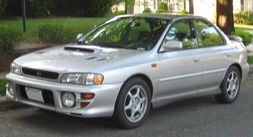
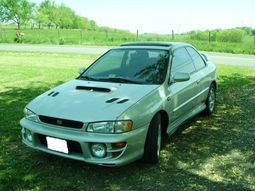

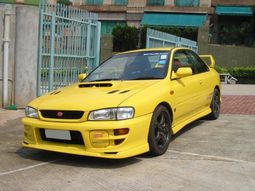
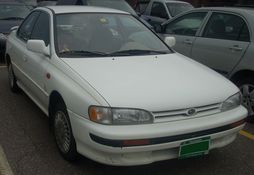

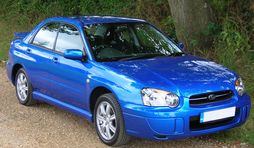

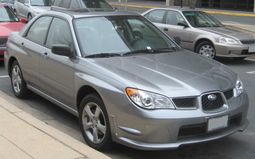
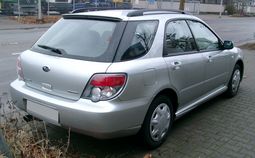
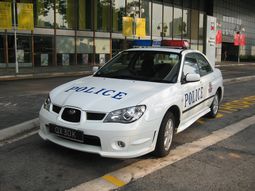
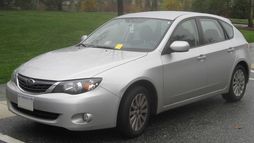
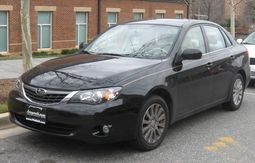
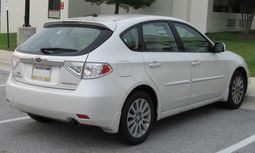
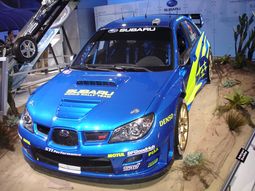
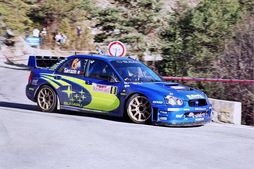
|